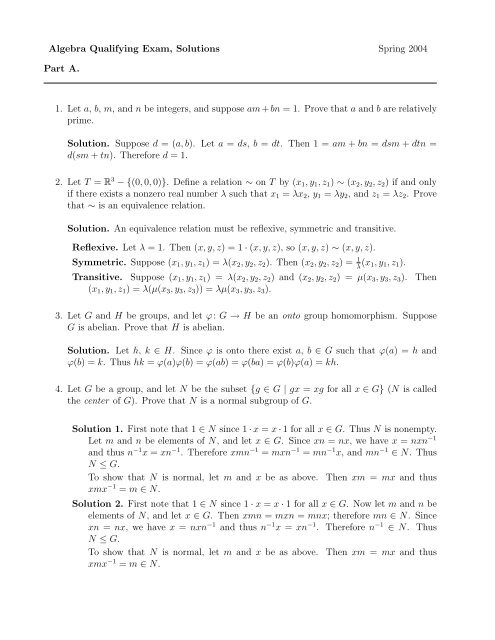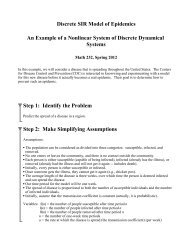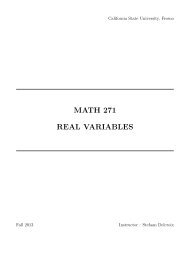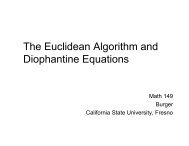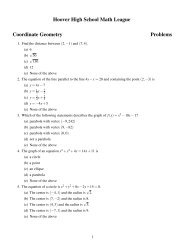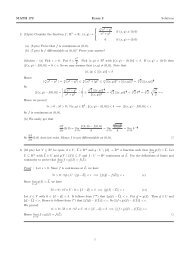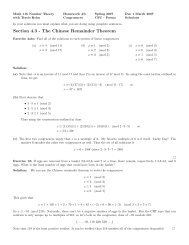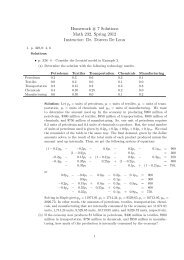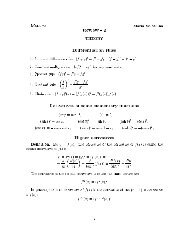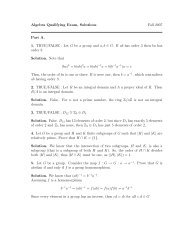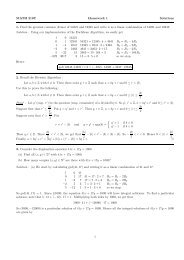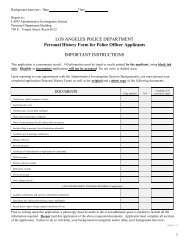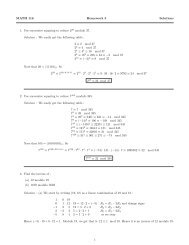Algebra Qualifying Exam, Solutions Spring 2004 Part A. 1. Let a, b ...
Algebra Qualifying Exam, Solutions Spring 2004 Part A. 1. Let a, b ...
Algebra Qualifying Exam, Solutions Spring 2004 Part A. 1. Let a, b ...
Create successful ePaper yourself
Turn your PDF publications into a flip-book with our unique Google optimized e-Paper software.
<strong>Algebra</strong> <strong>Qualifying</strong> <strong>Exam</strong>, <strong>Solutions</strong> <strong>Spring</strong> <strong>2004</strong><strong>Part</strong> A.<strong>1.</strong> <strong>Let</strong> a, b, m, and n be integers, and suppose am + bn = <strong>1.</strong> Prove that a and b are relativelyprime.Solution. Suppose d = (a, b). <strong>Let</strong> a = ds, b = dt. Then 1 = am + bn = dsm + dtn =d(sm + tn). Therefore d = <strong>1.</strong>2. <strong>Let</strong> T = R 3 − {(0, 0, 0)}. Define a relation ∼ on T by (x 1 , y 1 , z 1 ) ∼ (x 2 , y 2 , z 2 ) if and onlyif there exists a nonzero real number λ such that x 1 = λx 2 , y 1 = λy 2 , and z 1 = λz 2 . Provethat ∼ is an equivalence relation.Solution. An equivalence relation must be reflexive, symmetric and transitive.Reflexive. <strong>Let</strong> λ = <strong>1.</strong> Then (x, y, z) = 1 · (x, y, z), so (x, y, z) ∼ (x, y, z).Symmetric. Suppose (x 1 , y 1 , z 1 ) = λ(x 2 , y 2 , z 2 ). Then (x 2 , y 2 , z 2 ) = 1 λ (x 1, y 1 , z 1 ).Transitive. Suppose (x 1 , y 1 , z 1 ) = λ(x 2 , y 2 , z 2 ) and (x 2 , y 2 , z 2 ) = µ(x 3 , y 3 , z 3 ). Then(x 1 , y 1 , z 1 ) = λ(µ(x 3 , y 3 , z 3 )) = λµ(x 3 , y 3 , z 3 ).3. <strong>Let</strong> G and H be groups, and let ϕ: G → H be an onto group homomorphism. SupposeG is abelian. Prove that H is abelian.Solution. <strong>Let</strong> h, k ∈ H. Since ϕ is onto there exist a, b ∈ G such that ϕ(a) = h andϕ(b) = k. Thus hk = ϕ(a)ϕ(b) = ϕ(ab) = ϕ(ba) = ϕ(b)ϕ(a) = kh.4. <strong>Let</strong> G be a group, and let N be the subset {g ∈ G | gx = xg for all x ∈ G} (N is calledthe center of G). Prove that N is a normal subgroup of G.Solution <strong>1.</strong> First note that 1 ∈ N since 1 · x = x · 1 for all x ∈ G. Thus N is nonempty.<strong>Let</strong> m and n be elements of N, and let x ∈ G. Since xn = nx, we have x = nxn −1and thus n −1 x = xn −1 . Therefore xmn −1 = mxn −1 = mn −1 x, and mn −1 ∈ N. ThusN ≤ G.To show that N is normal, let m and x be as above. Then xm = mx and thusxmx −1 = m ∈ N.Solution 2. First note that 1 ∈ N since 1 · x = x · 1 for all x ∈ G. Now let m and n beelements of N, and let x ∈ G. Then xmn = mxn = mnx; therefore mn ∈ N. Sincexn = nx, we have x = nxn −1 and thus n −1 x = xn −1 . Therefore n −1 ∈ N. ThusN ≤ G.To show that N is normal, let m and x be as above. Then xm = mx and thusxmx −1 = m ∈ N.
5. <strong>Let</strong> S n denote the group of permutations on the set {1, 2, . . . , n}, and let A n denote thesubset consisting of even permutations.(a) Prove that A n is a normal subgroup of S n . You may assume A n is a subgroup of S n .(b) Prove that S n /A n is isomorphic to the group Z 2 = {0, 1}.Solution.(a) <strong>Let</strong> τ ∈ A n and let σ ∈ S n . If σ is even, then so is σ −1 . Similarly, if σ is odd, thenso is σ −1 . Therefore στσ −1 can be written as an even number of transpositions.{0 if σ is even(b) Solution <strong>1.</strong> <strong>Let</strong> ϕ: S n → Z 2 be defined by ϕ(σ) =1 if σ is odd .Clearly ϕ is an onto homomorphism since even ◦ even = even, odd ◦ odd = even,etc. Moreover, ker(ϕ) = A n . Therefore by the First Isomorphism Theorem,S n /A n∼ = Z2 .{0 if σ is evenSolution 2. <strong>Let</strong> ϕ: S n /A n → Z 2 be defined by ϕ(σA n ) =1 if σ is odd .Clearly ϕ is an onto homomorphism since even ◦ even = even, odd ◦ odd = even,etc. Moreover, |S n /A n | = 2 = |Z 2 |. Therefore ϕ is an isomorphism.6. <strong>Let</strong> R be a ring with identity element 1 R , and let I be an ideal of R. Prove that if 1 R isin I, then I = R.Solution. <strong>Let</strong> r ∈ R. Then since 1 R ∈ I we have r · 1 R = r ∈ I since I is an ideal of R.7. <strong>Let</strong> ϕ: C → C be defined by ϕ(a + bi) = a − bi for all a + bi ∈ C. Prove that ϕ is a ringisomorphism.Solution. Clearly ϕ is onto. ϕ is also one-to-one since if ϕ(a + bi) = a − bi = 0, thena = 0 and b = 0, and thus a + bi = 0. ϕ is a ring homomorphism since• ϕ((a + bi) + (c + di) = ϕ(a + c + (b + d)i) = a + c − (b + d)i = a − bi + c − di =ϕ(a + bi) + ϕ(c + di)• ϕ((a + bi)(c + di) = ϕ(ac − bd + (ad + bc)i) = ac − bd − (ad + bc)i = (a − bi)(c − di) =ϕ(a + bi)ϕ(c + di).Therefore ϕ is a ring isomorphism.8. Prove that the only ideals of a field F are {0 F } and F , where 0 F denotes the additiveidentity element of F .Solution. Suppose I is an ideal of F . If I = {0 F } then we are done, so suppose a ∈ I,a ≠ 0. Then there is an element a −1 ∈ F since F is a field. Therefore a −1 a = 1 ∈ I sinceI is an ideal. But by #6, this implies I = F .
<strong>Part</strong> B.⎡0 1 0⎤1<strong>1.</strong> <strong>Let</strong> A = ⎣0 0 2 4⎦, and let R be the reduced row echelon form for A.0 0 0 3(a) Find R, determine the (row) rank of A, and find a basis for the row space of A.(b) Find a matrix P such that P A = R.Solution. We need to perform row reduction on A to get to R. The matrices of theelementary operations we will use will yield P .A =→→⎡ ⎤0 1 0 1⎣0 0 2 4⎦ now we do R 1 ↦→ R 1 − 1 3 R 30 0 0 3⎡ ⎤0 1 0 0⎣0 0 2 4⎦ now we do R 2 ↦→ R 2 − 4 3 R 30 0 0 3⎡ ⎤0 1 0 0⎣0 0 2 0⎦ = R0 0 0 3It follows that⎡P = ⎣1 0 00 1 − 4 30 0 1⎤ ⎡⎦ ⎣1 0 − 1 30 1 00 0 1⎤⎡⎦ = ⎣1 0 − 1 30 1 − 4 30 0 1⎤⎦2. Find an orthonormal basis for the subspace of the Euclidean space R 3 spanned by thevectors v 1 = (1, 0, 1) and v 2 = (0, 3, 4).Solution. The first step on the Gram-Schmidt process says that we fix v 1 and define(1, 0, 1) · (0, 3, 4)u 2 = (0, 3, 4) − (1, 0, 1)|(1, 0, 1)| 2= (0, 3, 4) − 2(1, 0, 1)= (−2, 3, 2)So, right now we have an orthogonal basis. We obtain an orthonormal basis by dividingv 1 and u 2 by their norm. The final answer is{ }11√2 (1, 0, 1), √ (−2, 3, 2) 173. Prove: If S is a finite linearly independent subset of the vector space V and w ∈ V is notin the subspace spanned by S, then the set S ∪ {w} is linearly independent.
Solution. Consider a linear combination of the elements of S and w that is equal to zero.If the scalar with w is zero, then we have a linear combination of the elements of S that isequal to zero, thus all the scalars are equal to zero. If the scalar with w is different fromzero, then we can ‘solve’ for w and leave w as a linear combination of the elements of S,which would imply that w ∈ Span(S). A contradiction.4. <strong>Let</strong> V and W be vector spaces over the field F and let T be a linear transformation fromV into W . Suppose V is finite dimensional. Prove: rank (T ) + nullity (T ) = dim (V ).Solution. We know that V/ker(T ) ∼ = Im(T ). So, dim(V/ker(T ) = dim(Im(T )) =rank(T ).Sincethendim(V/ker(T )) = dim(V ) − dim(ker(T )) = dim(V ) − nullity(T )dim(V ) − nullity(T ) = rank(T )5. For each natural number n, determine the value of the determinant of the following matrix:⎡⎤1 2 3 4 · · · n1 0 3 4 · · · nA =1 2 0 4 · · · n⎢⎣.. .⎥. · · · . ⎦1 2 3 4 · · · 0Solution.det(A) ==1 2 3 4 · · · n1 0 3 4 · · · n1 2 0 4 · · · nnow we subtract row 1 to all rows. . .. · · · .∣1 2 3 4 · · · 0∣1 2 3 4 · · · n0 −2 0 0 · · · 00 0 −3 0 · · · 0. ... · · · .∣0 0 0 0 · · · −n∣= (−1) n−1 n! because the matrix above is upper triangular6. <strong>Let</strong> A be the symmetric matrixis a diagonal matrix.[ ] 1 −<strong>1.</strong> Find an orthogonal matrix T such that T−1 1−1 AT
Solution. Since A is symmetric, then its eigenvectors associated to distinct eigenvaluesmust be orthogonal. So, the only thing we have to do is to get the standard diagonalizationof A.The characteristic polynomial of A isFor λ = 0 we get the systemwhich has solution space spanned by (1, 1).For λ = 2 we get the systemχ A (λ) = (1 − λ) 2 − 1 = λ 2 − 2λ = λ(λ − 2)x − y = 0 − x + y = 0x − y = 2x− x + y = 2ywhich has solution space spanned by (1, −1).[ ] 1 1It follows that T =1 −17. <strong>Let</strong> A = (a ij ) be an n × n matrix over the reals. Show that A can be expressed in a uniqueway as A = S + K where S is symmetric and K is skew-symmetric. (Hint: Consider thematrices 1 2 (A + At ) and 1 2 (A − At )).Solution. Note that the matrix 1 2 (A + At ) is symmetric and that the matrix 1 2 (A − At ) isskew-symmetric. Also, note that12 (A + At ) + 1 2 (A − At ) = ANow we just have to check the uniqueness of the representation. So, we assume there arematrices M (symmetric) and N (skew-symmetric) such that A = M + N. So,M + N = 1 2 (A + At ) + 1 2 (A − At )which impliesM − 1 2 (A + At ) = 1 2 (A − At ) − NIn the previous equation the right hand side is skew-symmetric and the left hand side issymmetric. It follows thatM − 1 2 (A + At ) = 1 2 (A − At ) − N = 0Hence, the representation is unique.
8. <strong>Let</strong> A and B be n × n matrices and suppose A and B are similar. Show:(a) det(A) = det(B).(b) If A is nonsingular, so is B, and A −1 is similar to B −1 .Solution. Assume B = P AP −1(a) Since the determinant is multiplicative, thendet(B) = det(P AP −1 ) = det(P ) det(A) det(P −1 ) = det(P ) det(A) det(P ) −1 = det(A)(b) If A is nonsingular, then det(A) ≠ 0, which implies det(B) ≠ 0, and thus B isnon-singular. In this caseSo, A −1 is similar to B −1 .B −1 = (P AP −1 ) −1 = (P −1 ) −1 A −1 P −1 = P A −1 P −1


